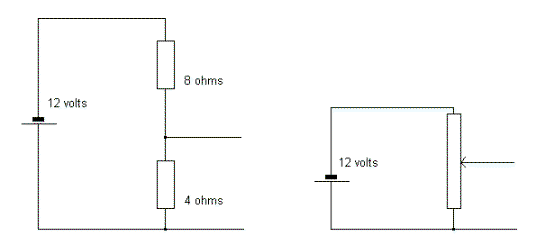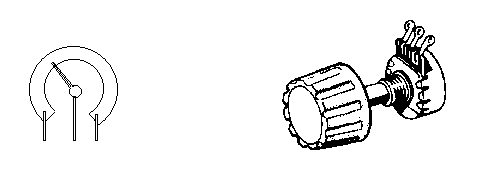|
Make sure that you
understand Ohms Law
before reading this.

The total resistance of
the two series resistors
is 8 ohms + 4 ohms = 12
ohms.
The current flowing
around the circuit is 12
volts/12 ohms = 1 amp
(Ohms Law).
The voltage across the 8
ohm is 1 amp x 8 ohms =
8 volts (again Ohms
Law).
The voltage across the 4
ohm is 1 amp x 4 ohms =
4 volts (Mr Ohm again).
The 12 volts of the
battery has been divided
into 8 volts and 4
volts.
By selecting values for
the two resistors, the
12 volts can be divided
into any two voltages
which add up to 12
volts.
For example, 3 volts and
9 volts, 6 volts and 6
volts etc.
A circuit requiring less
than 12 volts can be
connected across the
lower resistor, as long
as it requires a current
much lower than the
current through the two
resistors.
If a cardboard strip,
coated with carbon, is
connected across the
battery, together with a
"wiper" which can be
moved up or down the
strip, then you have a
POTENTIOMETER (POT for
short.)
With the wiper at the
top then the output is
12 volts.
With the wiper at the
bottom then the output
is zero volts.
Any output between 12
volts and zero can be
obtained by positioning
the wiper correctly.

In practice, the strip
is curved and the wiper
is joined to a spindle
which rotates the wiper
on the strip when a
control knob is twisted.
In the drawings, the
wiper is the centre
connection.
Most front panel
controls such volume and
brightness are "pots".
Their purpose is to
adjust the voltage fed
from one stage to the
next. |